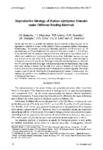Please use this identifier to cite or link to this item:
http://www.alice.cnptia.embrapa.br/alice/handle/doc/409919Full metadata record
| DC Field | Value | Language |
|---|---|---|
| dc.contributor.author | RAMALHO, F. S. | pt_BR |
| dc.contributor.author | MEZZOMO, J. | pt_BR |
| dc.contributor.author | LEMOS, W. P. | pt_BR |
| dc.contributor.author | BANDEIRA, C. M. | pt_BR |
| dc.contributor.author | MALAQUIA, J. B. | pt_BR |
| dc.contributor.author | SILVA, J. P. S. | pt_BR |
| dc.contributor.author | LEITE, G. L. D. | pt_BR |
| dc.contributor.author | ZANUNCIO, J. C. | pt_BR |
| dc.date.accessioned | 2013-06-27T23:30:42Z | - |
| dc.date.available | 2013-06-27T23:30:42Z | - |
| dc.date.created | 2009-02-20 | pt_BR |
| dc.date.issued | 2008 | pt_BR |
| dc.identifier.citation | Phytoparasitica, v. 36, n. 1, p. 30-37, Feb. 2008. | pt_BR |
| dc.identifier.uri | http://www.alice.cnptia.embrapa.br/alice/handle/doc/409919 | pt_BR |
| dc.description | An attempt was made to quantify the influence of prey scarcity on longevity and on the reproductive variables of females of the predatorPodisus nigrispinus (Dallas) (Heteroptera: Pentatomidae). The predators received prey (Alabama argillacea) of different sizes,viz., 50 mg (small prey) or 220 mg (large prey), for a period of 24 h, daily or every 2, 4, 8 or 16 days. In an additional trial, the predators were provided only with water or kept without food, in which latter condition they lived a significantly shorter time. Individuals that received large prey in excess (every day) and at 16-day intervals lived significantly less, while the longevity of those that fed on small prey did not differ significantly between feeding intervals. Predators that fed less frequently laid fewer eggs, with increased intervals between clutches. The results were more marked in females fed on small prey; however, evidence of trade-off between reproduction and survival was detected only in predators that received large prey. The results suggest a type of trade-off, where longevity is maintained at the expense of reproduction. This strategy can contribute to the establishment and survival ofP. nigrispinus in an environment of fluctuating food supply. | pt_BR |
| dc.language.iso | eng | eng |
| dc.rights | openAccess | eng |
| dc.title | Reproductive strategy of Podisus Nigrispinus females under different feeding intervals. | pt_BR |
| dc.type | Artigo de periódico | pt_BR |
| dc.date.updated | 2013-06-27T23:30:42Z | pt_BR |
| dc.subject.thesagro | Controle Biológico | pt_BR |
| dc.subject.thesagro | Predador | pt_BR |
| dc.subject.nalthesaurus | Podisus nigrispinus | pt_BR |
| riaa.ainfo.id | 409919 | pt_BR |
| riaa.ainfo.lastupdate | 2013-06-27 | pt_BR |
| dc.identifier.doi | 10.1007/BF02980745 | pt_BR |
| dc.contributor.institution | FRANCISCO DE SOUZA RAMALHO, CNPA; J. Mezzono, Embrapa Algodão; WALKYMARIO DE PAULO LEMOS, CPATU; C. M. Bandeira, Embrapa Algodão; J. B. Malaquia, Embrapa Algodão; J. P. S. Silva, Embrapa Algodão; G. L. D. Leite, UFMG; J. C. Zanuncio, UFV. | pt_BR |
| Appears in Collections: | Artigo em periódico indexado (CPATU)  | |
Files in This Item:
| File | Description | Size | Format | |
|---|---|---|---|---|
| 10.1007BF02980745.pdf | 511,29 kB | Adobe PDF |  View/Open |









